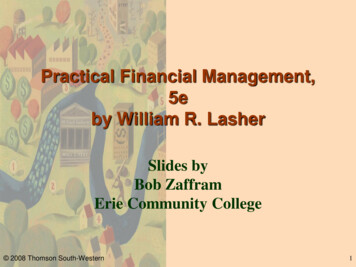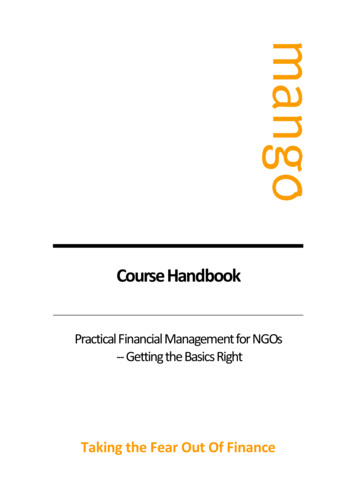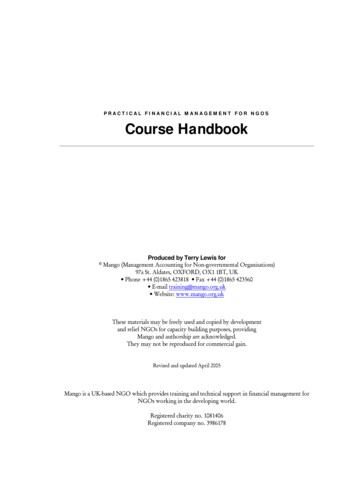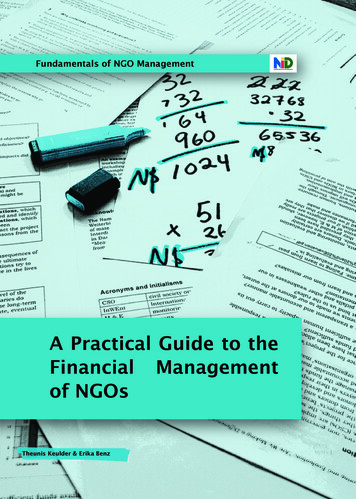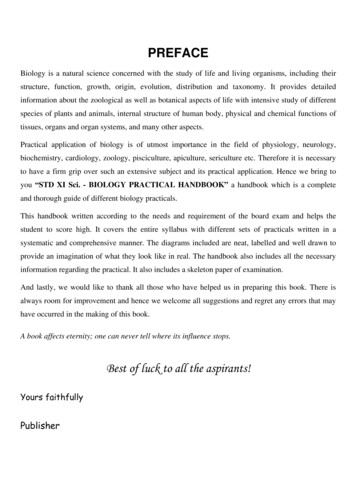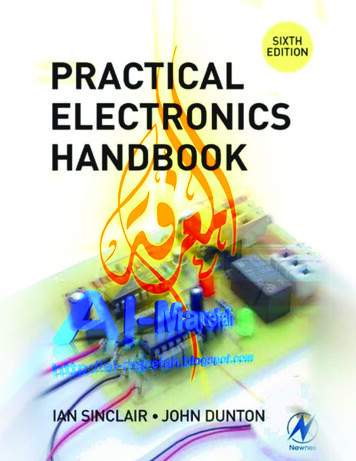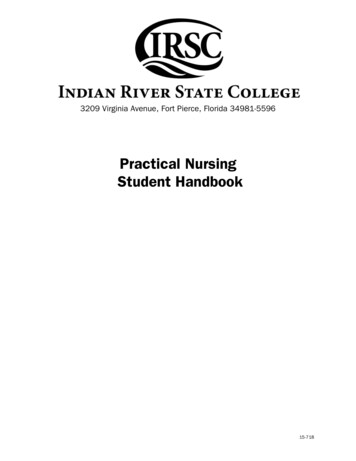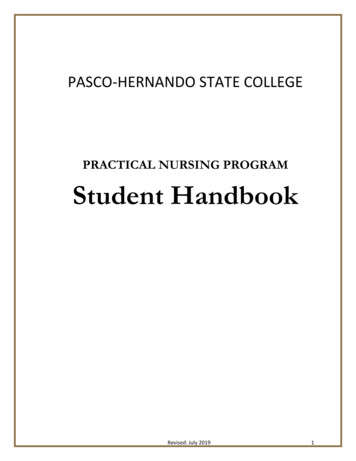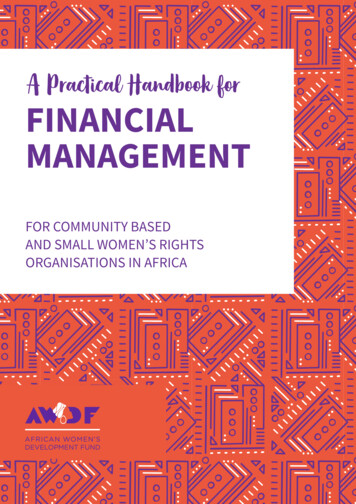
Transcription
A Practical Handbook forFINANCIALMANAGEMENTFOR COMMUNITY BASEDAND SMALL WOMEN’S RIGHTSORGANISATIONS IN AFRICA
CreditsOriginal author:Gertrude Bibi Annoh Quarshie, 2010Editor of updated version:Natalie Jeffers and Paige Ingram - Matters of the EarthGraphic Design:Lulu Kitololo StudioPublished by African Women’s Development Fund in2011Revised version published by African Women’sDevelopment Fund in 2017In this spirit of sharing feminist knowledge, thisdocument is distributed under a Creative Commonslicense that allows for noncommercial distribution inoriginal form with full credit given to the authors.Produced with support from the African CapacityBuilding Foundation.Visit http://awdf.org for more information,documents and toolsTwitter: @awdf01AWDF House, Justice Sarkodie Addo Avenue,East Legon, Accra, GhanaA note aboutthe designThe patterns in thispublication werehand-drawn anddesigned to be abstractrepresentations of thehandbook’s key themes.
ForewordThe African Women’s Development Fund wasfounded out of the need for African women to takegreater leadership around the resources allocatedto advancing rights and development on the Africancontinent. In almost two decades of our existence asa fund we aim to provide the ‘best quality’ possible inresourcing of African women’s organisations, payingattention both to the important work that they doto advance equality and justice, but also to addressthe needs that these organisations have for supportin adapting and managing the stresses created bypolitical and economic crises and emergencies, alongwith growing their organisations in scale and impact.AWDF stakeholders are formal and informal advisorsthat span different networks of African women rightsactivists and organisations extending to almost everycountry on the African continent. Some of thesenetworks include the African Feminist Forum and theAfrican Women Leaders Network on ReproductiveHealth and Family Planning, both events have beenhosted by AWDF for several years. Under the Leadingfrom the South grantmaking initiative (2017-2020),AWDF will also fund women’s rights organisations inselected countries in the Middle East.AWDF provides grants in the following thematicareas: Body and Health Rights Economic Security and Justice Leadership Participation and PeaceAWDF established the Capacity Building Unit inorder to provide more holistic support for ourgrantee organisations. Through capacity buildingprogramming we make targeted investments inAfrican women’s organisations to allow them toreflect, scale up and build efficient systems as wellas growing inspiring and accountable organisationalcultures. As Hope Chigudu, feminist organisationaldevelopment expert and long-time technicalconsultant to AWDF would put it - we invest to helpnurture organisations with a soul1. This kind of coreinvestment can be hard to find - particularly forsmaller African women’s organisations - as much ofthe funding available for women’s rights focuses onproject-based investments.At AWDF we believe that in order to achieve impactstowards our collective mission of advancing ourwomen’s rights we also need to dedicate resources tohelp build the capacity of changemaker organisations.As a donor, AWDF aims to support best practicefinancial management both internally and alsoamongst our grantees. We acknowledge that financialmanagement is an area that many smaller andcommunity based organisations needs support with,particularly when balancing smaller and projectspecific budgets, which make it difficult to costprofessional support around finances. We encouragegeneral finance management literacy among ourgrantees as well as providing specific training forfinance staff to strengthen internal systems andsustain good financial management practice.This guide was originally developed by AWDF staff,then updated by AWDF’s Finance Manager GertrudeBibi Annoh Quarshie based on the emergingneeds of grantees. This third update includesfurther information and research on financial riskmanagement and procurement.We hope that this document will continue to be usefulfor women’s rights organisations.We welcome feedback on how you are using it!Jessica HornDirector of Programmes, AWDFChigudu, H. and Chigudu, R., 2015. Strategies for Building an Organisation with a Soul. African Institute for Integrated Responses toViolence Against Women and HIV/AIDS (AIR).1
ContentsFOREWORD3What is a Control Environment20PREFACE5 Management’s Philosophy, Values andApproach20ACRONYMS/GLOSSARY620INTRODUCTION9 Participation and Relationships inGovernanceEffectiveness of Operations21 Realistic Strategic Plans21Reliability of Management’s Estimates22Why Financial Management?97 Principles of Financial Management10Strategic Challenges11How to Finance Now and in the Future11FINANCIAL LEADERSHIP AND SUSTAINABILITY 13ACCOUNTING RECORDS23Reward Policies23Salaries23Loans and advances to staff23Per diem24Gratuity accounts24Financial Sustainability13Diversified Funding Base13Unrestricted Funds13Financial Reserves13Strong Stakeholder Relationship14Organisational Sustainability14Chart of Accounts25Surviving Threats14Filing and Storage of Documents26Responding to Challenges15Accounting Software26C ASE STUDY: Resources,Skills and Managing 15ChallengesBuilding Blocks of Financial ManagementINTERNAL CONTROLS1717Why Internal Controls are Necessary 17Elements of Internal Control17Examples of Internal Controls18Weaknesses in Internal Controls18Managing Fraud Risk19Keeping Risks Low19INFRASTRUCTURECASH MANAGEMENT2528CASE STUDY: Sample Cash Book29Bank Reconciliation Statement30Minimum Cash Control Requirements31ASSETS: PROPERTY AND EQUIPMENT32Assets Policy33Disposal of Property and Equipment33Management of Company Vehicles33PROCUREMENT344
PrefaceProcedures or Guidelines34Methods35Why Procurement Matters36PLANNING & BUDGETING37Budget Techniques37Budgetary Control38CASE STUDY: Cash Flow Budgeting38REPORTING & MONITORING40Donor Reporting41CASE STUDY: Building a Financing Grid42Monitoring - External Audits43CONCLUSION44Recommended Reading45This handbook provides tools to support NGOs especially small women’s organisations in Africa - indeveloping general financial management techniquesto ensure the long term survival of their programmesand institutions.Financial management is often de-prioritised withlittle effort placed on recruiting qualified personnelto manage finances. This often leads to poor financialplanning, unsustainable organisational growth, lackof credibility and ineffective monitoring systems.This guide will enable all managers and staff inappreciating the importance of: Develop financial management systems andprocedures; Understand the impact of these systems on theoverall performance of your organisation; Enable non financial managers to locate theirrole in financial management and internalcontrols; Improve organisational transparency andaccountability mechanisms; Build basic strategies for long term financialsustainability.5
Acronyms/GlossaryAbbreviations/AcronymsAWDFAfrican Women’s Development FundNGOsNon Governmental OrganisationsERPEnterprise Resource PlanningGlossaryAccountability: The legal duty, placed on anindividual, group or organisation, to explain howfunds, equipment or authority given by a third/external party has been used.Cash Flow: Is the difference between the amountof actual cash coming in to an organisation such asgrants and the amount of actual cash going out of anorganisation in the form of expenses, such as salaries.Accounting software: A computer application thatrecords and processes accounting transactionswithin functional modules such as accounts payable,accounts receivable, payroll, and trial balance.Cash Flow Budget: A form of budgeting that requiresorganisations to project revenue and expenditures ona month-by-month basis throughout each fiscal year.Assets: Assets are what your organization has, what isowed to you, what you have invested in, and what youhave deposited with others.Audit trail: A system that traces the detailedtransactions relating to any item in an accountingrecord.Authorisation and Approval Controls: Activities thatmitigate the risk of inappropriate transactions andserve as fraud deterrents and enforce segregation ofduties.Budget: A plan of activities expressed in monetarytermsCash Management: A broad term that refers to thecollection, concentration, flow and disbursement ofcash. It encompasses a company’s level of liquidity,its management of cash balance, and its short-terminvestment strategies.Control Environment: The atmosphere in whichpeople conduct their activities and carry out theircontrol responsibilities.Control Consciousness: The control environmentis the control consciousness of an organization,representing the various measures taken bymanagement to protect the assets of the organisation.See also Control Environment.6
Control Activities: Procedures to ensure that anorganisation’s responses to risks are carried out.Fraud: A deliberate, improper action which leads tofinancial loss to the organisation.Cost Recovery: The act of recouping the costs of anygiven expense.Funding Mix: A continuum of different sources thatenables it to generate a steady income over time.Creditor’s Payment Schedule: Timeline by whichpayments are made to a contractor or creditor. Oncea pattern of payment is established, it is then possibleto estimate the cost each month. The estimatedfigures for payment will be used in the cash budgetto help determine any shortfall in the cash positionbefore the shortfall happens.Imprest: A sum of money that is set aside to coversmall, regular expenses. This sum is replenished whenit is used.Custodianship: Safekeeping of financial resources.Diversification: Securing funds from as wide a baseas possible – the local business community, thegeneral public, and not just external institutionaldonors.Donor Funding: When a business or organisation isfinanced by outside sources.Double Accounting: This occurs when more than onedonor being charged for the same expenses.Double Entry System: A system of bookkeepingwhere every entry to an account requires acorresponding to a different account, typically a debitand credit entry.Economies of Scale: A proportionate saving in costsgained by an increased level of production.External Audit: An independent examination of anorganisation’s financial statements.Filing: Storing information for future reference.Financial Management: Actions taken to ensurethe financial health of an organisation, including butnot limited to: planning, organising, controlling andmonitoring the financial resources of an organisation.Incremental Budgeting: Normally shows apercentage increase on the former budgeted or actualfigures.Integrity: The ability of an organisation to be honest,uphold moral principles and act in alignment withstated beliefs and community agreements. Integritybuilds the reliability, honesty and dependability of anorganisation.Internal Controls: Methods to ensure the integrityof financial and accounting information and meetoperational and sustainability target goals.Management Controls: Measures to evaluate variousmanagement resources such as human resources,financial resources, etc.Management Estimates: Predictions which occurwhen an organisation must make assumptions aboutmatters that are “highly uncertain.”Monthly Variance Analysis: Looks after-the-fact atwhat caused a difference between budgeted spendingand actual spending.Negative Cash Flow: When the amount of outflowingcash is higher than incoming cash within a given timeperiod.NGOs: International Non-GovernmentalOrganisations; A non-profit citizens’ group organizedand working towards societal impact on a local,national or international level.7
Non-deficit financing: Occurs when sufficientfunding is secured to cover all activities towardsmeeting an organisation’s objectives and sustainablegrowth.Order: The consistency of financial systems overtime. Order provides data and space for comparisons,analysis, and transparency.Overhead: Refers to expenses not related to directlabor, direct materials and/or third party expensesbilled directly to clientsPetty Cash: A set amount of cash fund available atany point in time for cash payments. As paymentsare made from this fund, it has to be topped up orreplenished because that fund has to be available.Per Diem: A specific amount of money anorganization gives an employee per day to cover livingexpenses when traveling for work.Personnel Controls: Methods or activities to helpstaff and employees be motivated.Reward policies: The benefits that are accrued tostaff who work for the organisation.Risk Assessment: An evaluation of the potential risksin a projected activity.Sale by Tender: A fixed, or tangible, asset is marketedfor sale with or without a guide price and there is adeadline for all offers.Self-financing: When a business or organisationfinances itself without receiving funds from outsidesources.Standard documentation: Maintaining financialrecords that can be understood by any accountant/financial specialist from anywhere in the world.Strategic Plans: An organisation’s method of definingits direction and comprehensive plan on how toachieve stated goals and objectives. This includesdecisions on the allocation of resources in support ofthese aims.Positive Cash Flow: When inflowing cash is higherthan the cash outflow within a given time periodTransparency: Openness of organisational processesin order to remain visible and trustworthy to thosewithin and outside of operations.Procurement: The process by which an organisationacquires goods and services or commissions work tobe done on its behalf by an external supplier.Un-presented Cheques: Those issued by theorganisation but are yet to be presented by therecipient.Pro-forma invoice: A preliminary bill of sale sentto buyers in advance of a delivery of goods, whichtypically includes a description of the purchaseditems and the cost along with other importa
FINANCIAL LEADERSHIP AND SUSTAINABILITY Financial Sustainability Diversified Funding Base Unrestricted Funds Financial Reserves Strong Stakeholder Relationship Organisational Sustainability Surviving Threats Responding to Challenges CASE STUDY: Resources,Skills and Managing Challenges Building Blocks of Financial Management INTERNAL CONTROLS .

